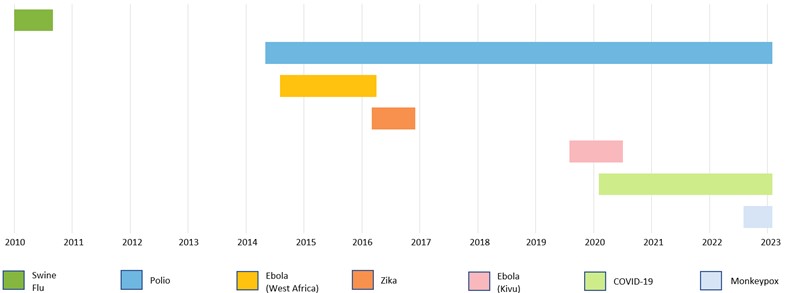Overseas infectious diseases of priority concern
This Surveillance report presents information on overseas infectious diseases of priority concern. These include Public Health Emergencies of International Concern (PHEICs), severe exotic respiratory diseases and severe vector-borne diseases.
View the interactive report below for time series maps and downloadable data.
On this page:
Public Health Emergencies of International Concern
The World Health Organization (WHO) can declare Public Health Emergencies of International Concern (PHEICs) when public health events arise that have international reach and may require an internationally coordinated response (WHO 2005). Since their inception in 2005, WHO has declared PHEICs seven times. As of January 2023, COVID-19, Polio and Mpox were all active PHEICs. A time series for these priority diseases can be seen in figure 1 [1, 2].
Figure 1: Summary of PHEICs from 2010-2023

COVID-19 has remained a PHEIC from 2020-2023
Coronavirus Disease 2019 (COVID-19) is the respiratory illness responsible for the COVID-19 pandemic. The disease first emerged in Wuhan, China (PRC) in late 2019 and quickly spread to most countries and territories [3]. The most common symptoms are fever, dry cough, and fatigue. About 80% of people who develop symptoms will recover without needing hospital treatment [3].
Polio remained a PHEIC in 2023
Poliomyelitis (polio) is a viral disease that can cause severe neurological disability and sometimes death. In addition to wild cirus, circulating weakened polio virus from oral polio vaccine (cVDPV) may cause polio in places where vaccination coverage is low (Venkatesan 2022). An injectable inactivated polio vaccine has replaced the oral polio vaccine in many countries including New Zealand. [4].
Mpox became a PHEIC in late 2022
Monkeypox (renamed mpox by WHO in late 2022) is a viral disease transmitted by contact with skin lesions, body fluids and respiratory droplets [5]. Despite being endemic in Western and Central Africa since 1970, mpox was a low priority disease until 2022 when an increase in global cases resulted in WHO classifying it as a PHEIC.
Eight recent respiratory diseases of concern were detected globally, 2018–2022
Measles, five types of serious non-seasonal influenza (‘Flu’) viruses, and two serious coronaviruses, MERS and COVID-19, of priority border health concern were reported between 2018 and 2022 [1].
